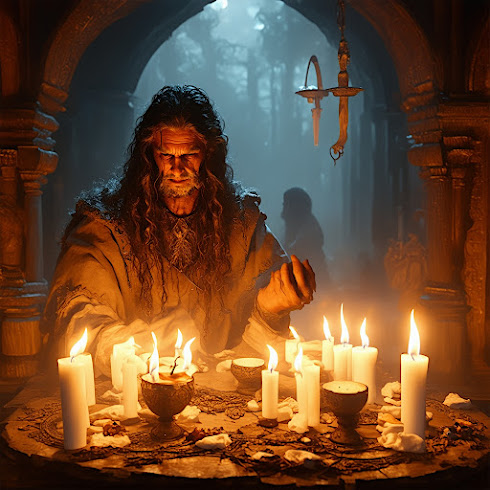What has come has gone, perhaps never to return, whether a Bronze Age collapse, Iron Age collapse, or not.
1-9. All things come to an end, some more unfortunately than others. The dark age cleric (or whomever is affected by this test) experiences austerity. Each result will compound when experienced more than once, and might only be undone once he (or the dark age cleric who caused it) rolls a magical side-effect of 12 at some point (see Part I).
As for what the thing affected is, roll 1d8: [i] magic spell, [ii] thing held, [iii] thing worn, [iv] thing consumed, [v] thing read, [vi] thing sat upon, [vii] mode of transport, [viii] furnishing.
Then roll any die for each of the following aspects. Once all have been determined, the full extent of the test will be readied, kept secret from the character(s) affected until it comes to pass.
[1] Thing affected: the last thing used (evens) or the next thing to be used (odds).
[2] Extent of effect: that one thing or duplicates of it (evens) or other things generally like it too (odds).
[3] Degree of effect: the thing now only works at 50% its usual amount (evens) or is completely broken, lost, or unavailable (odds). Those unaffected by the test who are kind enough to attempt to provide the one(s) affected with it must themselves save vs. spell/ make a Will save DC 15. If they succeed, they can then provide them with it, but it will only last for 1 day. If they fail, then they now suffer the test too.
[4] Range of effects: just the one who is tested experiences this loss (evens) or his friends and allies are affected too (odds).
For example, if it were a magic spell affected, then rolling evens, evens, odds, evens would indicate that it would be the last magic spell used (not the next one attempted), that it would be only that spell (not others like it), that it would be completely gone (not just at 1/2 power), and that only the one tested (likely the dark age cleric) would be unable to use that spell again until a magical side-effect #12 was rolled.
On the other hand, if it were a thing read, then rolling odds, odds, evens, and then odds would show that it would be the next thing that is to be read, it would be all written works like it (not just it or copies of it), that it would only be half there (not completely gone), but not only would the one tested, but his allies would not have full access to that written source too. Others unaffected could attempt to provide them with a full copy for 1 day's time, but risk being affected themselves.
10-16. The grim loss extends its reach. One of the following that's closest to where the dark age test occurs becomes defunct, abandoned, or simply gone, along with any items and people that would be there. Those who then attempt to venture to such a haunt must save vs. death/ make a Will save DC 10 or become unnerved, suffering -1d6 to all rolls for the next 3d6 rounds, whether from the actual darkness that has descended upon the place or just by realizing the consequential dark tidings that are likely to occur from the place's loss.
[2] Storehouse- scarcity of goods (1d10% chance of something sought for being unable to be found)
[3] Religious- darker mood (-1d2 to all rolls unless normally in a dark mood)
[4] Learning and/or Writing- backwardness (-1d3 to Intelligence checks)
[5] Seat of Authority- lawlessness (-1d3 to checks made to follow rules)
[6] Production- things in disrepair (1d10% chance of something used breaking)
[7] Residence- depopulation (1d10% chance of individuals that would otherwise be encountered being gone instead)
[8] Socializing- factionalism (-1d3 to rolls made to retain loyalty)
17+ The brigands who smashed the old world remain, and 2d4 of them just happen to find the dark age cleric within the next 1d20 turns. Focusing on destroying any elements of civilization they encounter (especially those listed for test results #10-16 above), they remain until slain. And for every dark age test result over 17, increase their number by d4 more. Roll 1d4 to see what occurs.
- Treat them as dark age clerics, except that these diviners fight as and have the armor and weapon restrictions of magic-users.
- They also cannot turn, and only know and can cast divination spells, but they still can use their divinity's mysteries.
- In return, thanks to their trafficking with spirits, they have access to and can cast any divination spells they wish and without need for preparation, as long as they are of high enough level and have enough spell uses available that day to cast them.
- Still, they must also roll for Soothsayer Magical Side-Effects when casting their spells (see below) in addition to those of dark age clerics.



